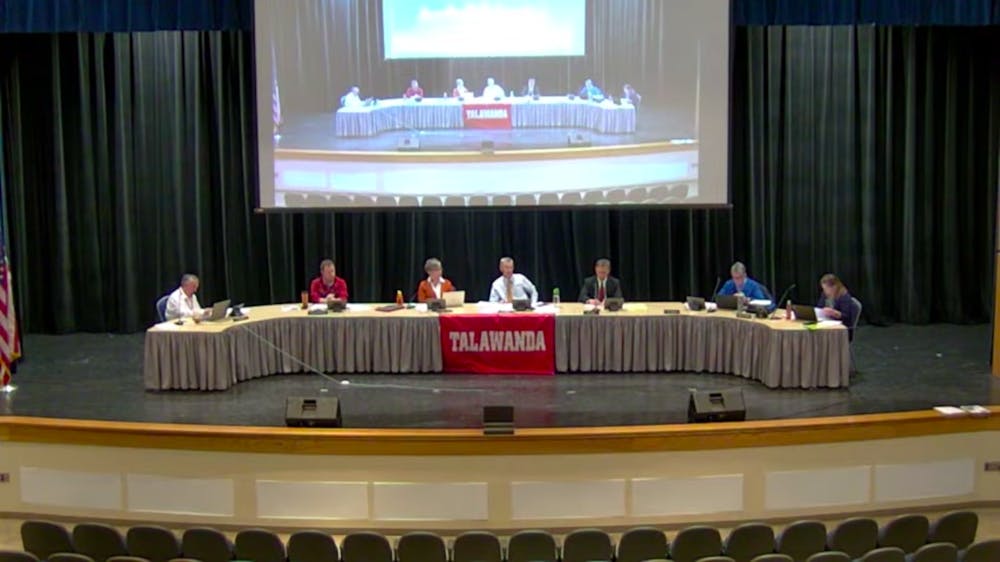The Talawanda School Board members passed budget reductions proposed by superintendent Ed Theroux at its meeting on Dec. 15. The board hopes to help save money and boost revenue for the Talawanda School District (TSD).
Among the cuts were student extracurricular activities, busing transportation and faculty and staff positions.
Pat Meade, president of the school board, voted for the plan despite his disapproval of the situation.
“It is very sad, and I’m going to vote yes on this, and it goes against everything I believe in,” Meade said. “But there’s a reality that we, the board, don’t have the money to continue to do the things we know are the right things to do.”
The cuts come after an operating levy failed to pass during the midterm elections. If the levy had passed, it would have generated $4.8 million a year to dig the school district out of a deficit.
To compensate for the shortfall, the school board held a work session to create recommendations that would yield $5.3 million over the next three years. To reach this goal, the school district would have to save $75,000 this year, $1.2 million next year, $1.7 million the following year and $2.4 million the subsequent school year.
“We understand that we need to increase revenue and/or decrease our expenditures so that we can continue to operate without any type of fear of state takeover,” Theroux said. “Even doing this $5.3 million worth [of] reductions and revenue generation, that will push us back to about 2029-2030 before we run out of money.”
If the school district continues to operate in a deficit, an Ohio auditor will evaluate the school board’s spending and make cuts, regardless of input from the board.
Three different options were presented at the meeting to reach the $75,000 goal. The second option passed with a vote of 3-2 and will generate $81,079. The plan will start in the spring 2023 semester.
Savings for the current school year
Under the second option, the school district will bring back the pay-to-play fee, which was suspended in 2018. The fee will be $170 for high school students per sport and $85 for middle school students per sport. Band students will also have to pay the same amount, and it will generate an estimated $22,015.
Enjoy what you're reading?
Signup for our newsletter
The plan will also eliminate busing for extracurricular activities in the spring. This will save an estimated $16,579. The remaining $42,485 will be pulled from a “dormant fund” which is money that has been collected from the classes of 2006-2022 for miscellaneous student activities.
“I’m supporting this one because it hits the mark that we set, but it’s less of a burden for families who didn’t budget for it at the beginning of the school year,” Kathleen Knight-Abowitz, a member of the school board, said.
Two other plans were discussed but not approved by the board members. The first plan would have raised the pay-to-play fee to $500 for high school students per sport and $250 for middle school students per sport. Busing for extracurricular activities in the spring would have been eliminated as well. This plan would have also generated $81,079 and would have saved the dormant funds.
The last plan would have eliminated busing for spring extracurricular activities and used the dormant funds, but would not impose a pay-to-play fee. This plan would have only generated $59,064, just short of the $75,000 goal. Rebecca Howard, a member of the school board, supported this option despite it not reaching the financial objective.
“I’m the one who came up with this dormant funds idea, and I did that largely because I have a problem with instituting pay-to-[play] for athletes and musicians whose families have already made plans to participate this year without an anticipation of having to pay anything for it,” Howard said.
Savings for the next three years
To reach the $5.3 million goal, next year TSD aims to save $1.2 million by hiring fewer employees, reducing costs in the curriculum and removing staff positions such as paraprofessionals, who help children with disabilities, and school resource officers, who promote safety in schools.
For the 2024-25 school year, TSD hopes to save $1.7 million by removing art and elective teachers in Talawanda middle school and high school, eliminating gifted teachers and removing all extracurriculars.
During the 2025-26 school year, TSD’s goal is to save $2.4 million by shortening the elementary school day and eliminating art, music and physical education, increasing the class sizes at the high school and middle school, and removing two psychologists and three counselors from the elementary schools.
“We are moving towards state minimum,” Theroux said. “As I make this plan, and we share these recommendations, understand there will be more recommendations coming forward … We will need to ensure that we’re meeting these goals.”
Budget cuts will also be made in busing throughout the next three years, but Theroux and the school board are still discussing what that will look like.
The motion for the three-year plan passed unanimously.
Further information on all the cuts being made can be found here.




